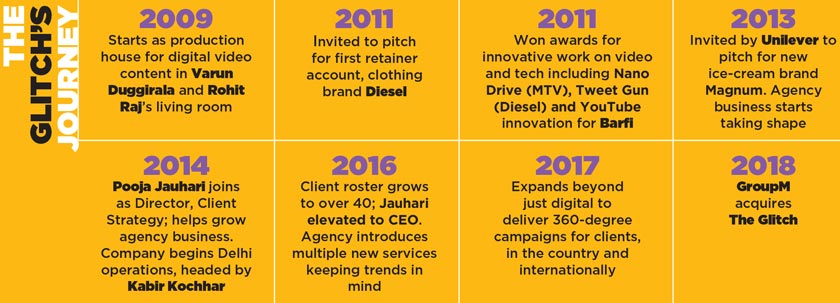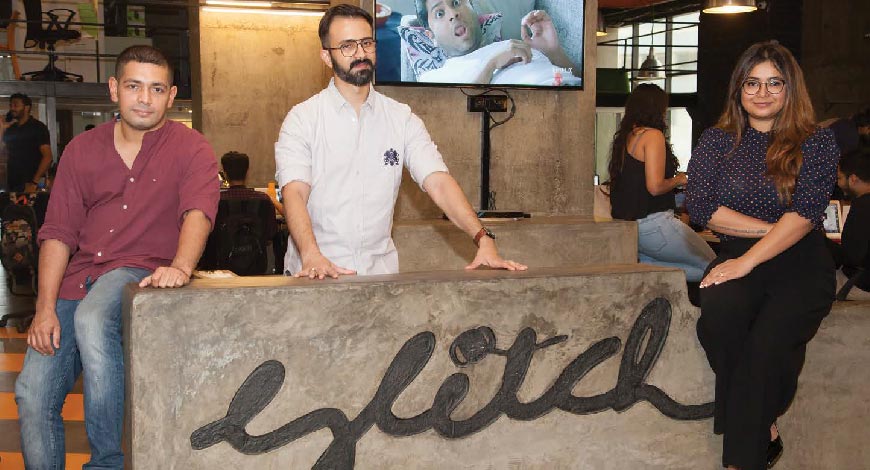BY SAMARPITA BANERJEE
Back in 2009, when the world was hit by the recession, college batchmates Varun Duggirala and Rohit Raj decided to quit their jobs at Channel V after it decided to pivot away from music. While the timing for taking such a step would seem inappropriate and risky to most, for the duo, it turned out to be a blessing in disguise.“We were told by a lot of people that it was the worst time for us to make the shift,” says Duggirala. However, he adds that it turned out to be the best time because that was when clients were on the lookout for smarter solutions. “And that is exactly what we were equipped to provide them with. At that point of time, nobody was doing much in the Digital space. We started off working with a set of clients that we already knew, mainly from the TV network. Gradually, thanks to word-ofmouth, people saw the kind of work we were doing, and liked it,” he adds.
In the last nine years, The Glitch has come a long way. Having started off as a production house for the web, it evolved into an innovation company for the digital space, then to a digital agency and finally to its current form, a 360-degree integrated communications company. It was probably this constant adaption to change and the quality of work which they came up with, that finally led to its acquisition by GroupM recently. Duggirala stresses that the evolution has been an important step in transforming the organization into what it is today, and is perhaps what differentiates them from a lot of other agencies out there. “Today we don’t live in a world where you draw up a structure and clients come and work within that. You need to create your structure based on what clients want. We were able to do that for our clients, which worked in our favour,” says Duggirala.
THE JOURNEY SO FAR
It was at a marketing conference that Duggirala and Raj met Pooja Jauhari, the agency’s CEO. They exchanged cards because Jauhari liked what the duo had to offer and wanted them to make a pitch for the organization she was working for then. Once the pitch was made, their work impressed her and she wanted to be a part of the organization. “It was a great pitch; albeit with some elements where I thought they could improve. For me, it was an opportunity. I reached out to them and told them, “Hey give me a job and I will show you how to do it.” I lobbied for my job because I saw the work that they were doing and saw its potential in the future. I wanted to be a part of all the action and wanted to use my experience to see how we could make it far more effective as an agency.”
ABOUT FLUX @THE GLITCH
Recently, The Glitch announced the launch of Flux@The Glitch, a specialized new age content division. Duggirala elaborates, “The division will be divided into three broad units – a studio part that will work with brands to create around 300-500 pieces of content in a year. Our aim would be to figure out how to help brands create content at scale, while ensuring a premium on quality. The second division is called the ‘Creator Lab’ where we are working with a lot of creative in the content space. We will try to understand how they can convert their work to branded content without moving away from the core essence of their content. And the last part of it is what we are calling our ‘Content Hub’ which is really about taking an effective look at long-form content.”
This was a time when Digital agencies were given a much smaller piece of the marketing pie. Jauhari continues, “Brand managers were not talking to us continuously and we realised that if we weren’t talking to them through the year, we weren’t important partners to them. When we look back on that time now, we realised that we would never have the ‘important chair’ during client meetings and would sit in a corner during the interactions. We realised very soon that the only way we could move from that corner to an important spot was if we showed them how to sell the product. It’s all about effective marketing and that’s been the game-changer for us. We help sell products creatively.”
However, it wasn’t really easy for a Digital agency to sell themselves in a market that was still just learning to grapple with the lightening pace at which the Digital ecosystem was evolving. Says Raj, “Frankly, when we started, the first few years were spent only on educating brands. But that was the space we came from. Channel V and MTV taught us the art of being nimble, agile and fast. We are the generation that saw the transformation from one channel to multiple channels, to the eventual move to smartphones. It was easy for us to work around those pieces, and that clearly gave us the edge.”
However, things are much different now with more and more advertisers opening up to not only investing more on Digital but also experimenting with its different forms. Today, the agency has acquired an impressive portfolio of clients including Netflix, Nokia, HUL, Linkedin, PayU, Star India and Marico, among many other international brands from the entertainment, beauty and FMCG sectors.
So what is it that differentiates them from other Digital agencies in the country? “From the very beginning, our aim has been to make sure that once we meet a client, they should never leave us. We should be able to do everything for them. And that’s what we do, we build expertise in our area of creative work that can really take care of end-to-end solutions for our clients,” says Jauhari. “We are the Swiss Army knife of agencies,” quips Raj with a smile.
The agency today is 265-member strong. With offices in Mumbai and Delhi currently, it’s eyeing the Bangalore market for an expansion soon. Moreover, it’s also planning to enter two international markets.
LIFE AFTER THE ACQUISITION
While acquisitions of independent agencies usually bring with it an obvious fear of the loss of power and independence, when asked how things have changed post the acquisition, all three answered almost in unison, “Nothing really.” The agency had been approached by a lot of other agencies and networks before they finally said yes to GroupM.

So what was it that made them say yes to GroupM? Raj says, “GroupM complemented us. Our strength has been creative strategy. But distribution hasn’t been our key strength and that’s where GroupM came in. Moreover, they come with a great understanding of data. We are always looking at the future and trying to figure out how to stay relevant and modern. And the future is going to be data-led.”
Moreover, Duggirala says that it was the mindset that GroupM approached them with that made them say “yes”. “They came into the equation saying, ‘We like what you are doing and it’s obviously working.’ They wanted to help us grow, and work with us to create better and more effective solutions for clients. That was where we really found common ground. GroupM also has a strong focus on content – an expertise it has built upon for years. There is great synergy in that respect as well, and all the pieces felt right,” says Duggirala.
Adds Jauhari, “They are also a great set of people. In our first meeting with GroupM, the way they spoke to us made it obvious that they were aware of the importance of the work that we do and were also aware of how this partnership could blossom. We were not sitting there on a negotiating table talking numbers, but were really talking about the future of communication.”
It’s already been over two months since the acquisition. So how have things worked out so far? Duggirala says, “We spent the first two months speaking to people across all GroupM agencies - across categories and functions. It has been overwhelming to see a lot of positivity and camaraderie because they are all people who really want to work with us and vice-versa. We have a common goal – that of coming out with the best solutions for our clients. We have already started off on a bunch of projects together, both in the content space and on individual brands.”
@ FEEDBACK
samarpita.banerjee@exchange4media.com
























